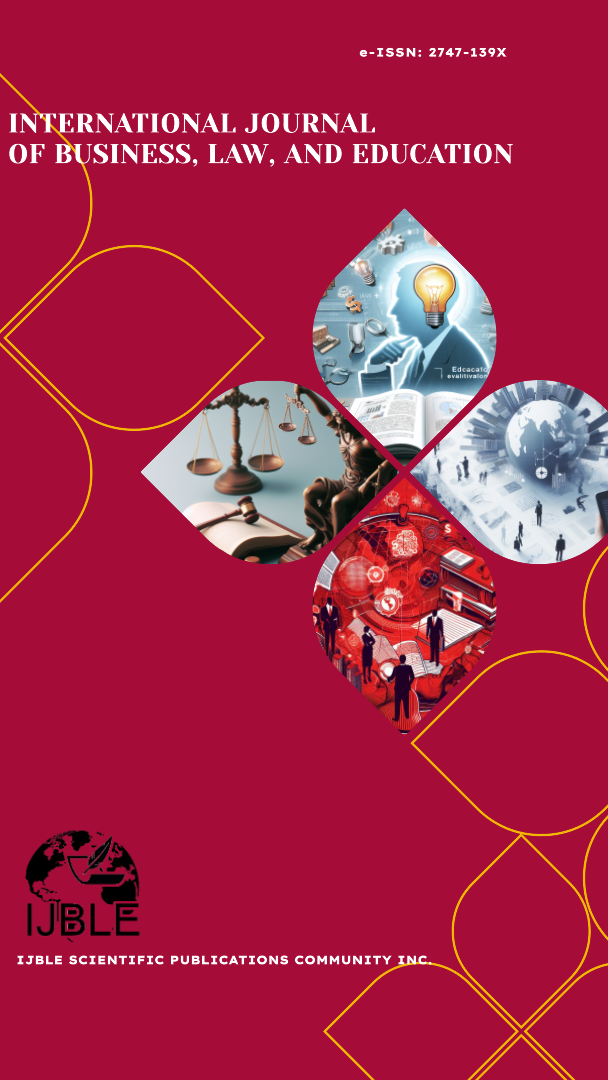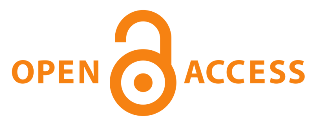Does Leadership Style Improve Employee Performance? The Mediating Role of Incentives
DOI:
https://doi.org/10.56442/ijble.v6i2.1183Keywords:
Leadership Style, Incentives, Employee Performance, Business OrganizationsAbstract
From ancient times to the current era of digital disruption in the 5.0 society phase, the implementation of the right leadership style can improve employee performance, with effective work incentive policies playing a crucial role in strengthening it. The purpose of this study is to investigate whether leadership style can improve employee performance, by examining the mediating role of incentives. This research design uses a quantitative approach with a survey type, with the predictive power effect size relied on in the constructed research model. The research instrument was administered to 107 respondents as a research sample selected using a purposive sampling technique. Statistical analysis adapted the path analysis model by applying the SPSS PROCESS macro model to test the mediation effect. The research findings indicate that leadership style has a positive and significant direct and indirect effect on employee performance. Leadership style has a positive and significant effect on work incentives. Work incentives have a positive and significant mediation effect with moderate to strong predictive power. These findings can fill the existing gap and expand the literature in the field of human resource management and ideal behavior in business organizations. Leadership style can strengthen efforts to improve employee performance in business organizations, with work incentives acting as a crucial mediator that becomes a sensitive axis that decorates it appropriately can strengthen it.
References
Abdel-Azim, & Tarek, M. (2018). The Effects of Transformational Leadership onthe Employees Change Readiness: the Moderating Role of the Incentive Schemes. Journal of Business Research, 40(4), 3–65. https://doi.org/10.21608/zcom.2018.148772
Aladekomo, A. T., & Obi, S. N. (2023). Influence of leadership styles, incentives and psychological resilience on job effectiveness among lecturers of private universities in Southwest, Nigeria. Ife Psychologia, 31(2), 67–74.
Alghizzawi, M., Ahmed, E., Alhawamdeh, Z. M., & Almhaisen, F. (2024). A Key Factor in Leadership Style with Employee Performance: A Comparative Analysis BT - The AI Revolution: Driving Business Innovation and Research: Volume 2. In B. Awwad (Ed.), Part of the book series: Studies in Systems, Decision and Control (pp. 873–883). Springer Nature Switzerland. https://doi.org/10.1007/978-3-031-54383-8_66
Alhudhori, M., Adriani, E., Zahari, M., & Albetris, A. (2019). Pengaruh Gaya Kepemimpinan dan Insentif terhadap Motivasi Serta Dampaknya terhadap Kinerja Pegawai Dinas Peternakan dan Perikanan Kabupaten Bungo. Ekonomis: Journal of Economics and Business, 3(2), 177–185.
Aluko, H. (2019). Effect of financial and non-financial incentives, organisational culture and leadership styles on employee motivation and how the impact influences the performance of employees: Empirical evidence from the Nigerian public sector (pp. 1–367). Cardiff Metropolitan University.
Baig, S. A., Iqbal, S., Abrar, M., Baig, I. A., Amjad, F., Zia-ur-Rehman, M., & Awan, M. U. (2021). Impact of leadership styles on employees’ performance with moderating role of positive psychological capital. Total Quality Management & Business Excellence, 32(9–10), 1085–1105. https://doi.org/10.1080/14783363.2019.1665011
Bass, B. M. (1999). Two decades of research and development in transformational leadership. European Journal of Work and Organizational Psychology, 8(1), 9–32. https://doi.org/10.1080/135943299398410
Bass, B. M., & Riggio, R. E. (2010). The transformational model of leadership. Leading Organizations: Perspectives for a New Era, 2(1), 76–86.
Bass, B. M., & Stogdill, R. M. (1990). Bass & Stogdill’s handbook of leadership: Theory, research, and managerial applications (3rd ed.). Simon and Schuster.
Belonio, R. J. (2012). The effect of leadership style on employee satisfaction and performance of bank employees in Bangkok. AU-GSB e-Journal, 5(2).
Biloa, X. S. (2023). The impact of leadership style on employee job performance. Open Journal of Leadership, 12(4), 418–441. https://doi.org/10.4236/ojl.2023.124020
Budiarti, I., & Firmansyah, D. (2024). Innovation capability: Digital transformation of human resources and digital talent in SMEs. Journal of Eastern European and Central Asian Research (JEECAR), 11(3), 621–637. https://doi.org/10.15549/jeecar.v11i3.1709
Budiarti, I., & Firmansyah, D. (2025). Sustainable SMEs Performance: Knowledge Management, Human Resources Digital Transformation, and Innovation Capabilities – A Practical Approach to Business in the Digital Age. In Preprints. Preprints. https://doi.org/10.20944/preprints202502.1713.v1
Caillier, J. G. (2014). Toward a better understanding of the relationship between transformational leadership, public service motivation, mission valence, and employee performance: A preliminary study. Public Personnel Management, 43(2), 218–239. https://doi.org/10.1177/0091026014528478
Caillier, J. G. (2016). Do transformational leaders affect turnover intentions and extra-role behaviors through mission valence? The American Review of Public Administration, 46(2), 226–242. https://doi.org/10.1177/0275074014551751
Campbell, J. W. (2018). Efficiency, Incentives, and Transformational Leadership: Understanding Collaboration Preferences in the Public Sector. Public Performance & Management Review, 41(2), 277–299. https://doi.org/10.1080/15309576.2017.1403332
Casas-Arce, P., & Martínez-Jerez, A. (2024). Leadership Style and Incentives.
Chen, M. Y.-C., Lin, C. Y.-Y., Lin, H.-E., & McDonough, E. F. (2012). Does transformational leadership facilitate technological innovation? The moderating roles of innovative culture and incentive compensation. Asia Pacific Journal of Management, 29(2), 239–264. https://doi.org/10.1007/s10490-012-9285-9
Chepkemoi, J. (2018). Effect of incentives on employee performance At Kenya forest service Uasin Gishu county. IOSR Journal of Business and Management (IOSR-JBM), 20(3), 26–32. https://doi.org/10.9790/487X-2003112632
Dastane, D. O. (2020). Impact of leadership styles on employee performance: A moderating role of gender. Australian Journal of Business and Management Research, 5(12), 27–52. https://ssrn.com/abstract=3732731
Donkor, F., Dongmei, Z., & Sekyere, I. (2021). The mediating effects of organizational commitment on leadership styles and employee performance in SOEs in Ghana: A structural equation modeling analysis. Sage Open, 11(2), 21582440211008896. https://doi.org/10.1177/21582440211008
Edison, E. Y. . (2017). Manajemen Sumber Daya Manusia. Bandung: CV. Alfabeta.
Firmansyah, D. (2023). Manajemen Sumber Daya Manusia: Fungsi dan Peran SDM Perusahaan, Kompetensi Strategis di Industri 4.0. In Eureka Media Aksara. Eureka Media Aksara.
Firmansyah, D. (2024). Model Peningkatan Daya Saing Ekonomi UMKM Berbasis Pendidikan dan Pelatihan Sektor Industri Kreatif Di Jawa Barat (pp. 1–721). Universitas Pendidikan Indonesia.
Firmansyah, D., Ahman, E., & Wahdiniwaty, R. (2024). Economic Competitiveness of SMEs: Digital Literacy, The Mediating Role of Digital Transformation and Innovation Capability. MIX: JURNAL ILMIAH MANAJEMEN, 14(2), 294–318. https://doi.org/10.22441/jurnal_mix.2024.v14i2.002
Firmansyah, D., & Saepuloh, D. (2022). Daya Saing: Literasi Digital dan Transformasi Digital. Journal of Finance and Business Digital, 1(3), 237–250. https://doi.org/10.55927/jfbd.v1i3.1348
Firmansyah, D., Susetyo, D. P., Suryana, A., & Saepuloh, D. (2022). Volume Penjualan: Analisis Pendekatan Regresi Data Panel. Asian Journal of Management Analytics, 1(2), 109–124. https://doi.org/10.55927/ajma.v1i2.1479
Firmansyah, D., Susetyo, D. P., Wahdiniwaty, R., Syafei, M. Y., & Omar, A. A. (2024). Contemporary Mask Theory: The Study of Behavior and Personality–A Behavioral Approach to Management and Accounting. Electronic Journal of Education, Social Economics and Technology, 5(2). https://doi.org/10.33122/ejeset.v5i2.245
Firmansyah, D., & Wahdiniwaty, R. (2023a). Happiness Management: Theoretical, Practical and Impact. International Journal of Business, Law, and Education, 4(2), 747–756. https://doi.org/10.56442/ijble.v4i2.244
Firmansyah, D., & Wahdiniwaty, R. (2023b). Prediction of Innovation Capability: the Role of Mediation in the Relationship between Digital Transformation and Competitiveness with the PLS-SEM Model. International Journal of Management and Business Intelligence, 1(2), 125–142. https://doi.org/10.59890/ijmbi.v1i2.238
Ghozali, I. (2014). Structural Equation Modelling, Metode Alternatif dengan Partial Least Square (PLS) (4th ed.). Semarang: Badan Penerbit Universitas Diponegoro.
Gujarati, D. N. (2012). Dasar-Dasar Ekonometrika, Terjemahan. Buku 2 (5th ed.). Jakarta: Salemba Empat.
Hair, J. F., Ringle, C. M., & Sarstedt, M. (2011). PLSSEM: Indeed a Silver Bullet Journal of Marketing Theory and Practice. Journal of Marketing Theory and Practice, 19(2), 139–152. https://doi.org/10.2753/MTP1069-6679190202
Hayes, A. F. (2018). Introduction To Mediation, Moderation, and Conditional Process Analysis : A Regression-Based Approach. The Guilford Press: New York & London.
Khan, H. (2008). An Introduction to Public Administration. University Press of America.
Khassawneh, O., & Elrehail, H. (2022). The effect of participative leadership style on employees’ performance: The contingent role of institutional theory. Administrative Sciences, 12(4), 195. https://doi.org/10.3390/admsci12040195
Kock, N., & Lynn, G. (2012). Lateral collinearity and misleading results in variance-based SEM: An illustration and recommendations. Journal of the Association for Information Systems, 13(7).
Larik, K. A. (2022). Effect of leadership style on employee performance. Neutron: Jurnal Rekayasa Teknik Sipil, 21(02), 112–119.
Lee, Y. L. A., Malik, A., Rosenberger III, P. J., & Sharma, P. (2020). Demystifying the differences in the impact of training and incentives on employee performance: mediating roles of trust and knowledge sharing. Journal of Knowledge Management, 24(8), 1987–2006. https://doi.org/10.1108/JKM-04-2020-0309
Masood, S. A., Dani, S. S., Burns, N. D., & Backhouse, C. J. (2006). Transformational leadership and organizational culture: The situational strength perspective. Proceedings of the Institution of Mechanical Engineers, Part B: Journal of Engineering Manufacture, 220(6), 941–949. https://doi.org/10.1243/09544054JEM499
Nnubia, A. L. (2020). Monetary incentives and employee performance of manufacturing firms in Anambra State. International Journal of Innovative Finance and Economics Research, 8(1), 10–22.
Northouse, P. (2007). Leadership Theory and Practice (3rd ed.). SAGE Publications, inc.
Ohemeng, F. L. K., Amoako-Asiedu, E., & Obuobisa Darko, T. (2018). The relationship between leadership style and employee performance: An exploratory study of the Ghanaian public service. International Journal of Public Leadership, 14(4), 274–296. https://doi.org/10.1108/IJPL-06-2017-0025
Otieno, B. N., & Njoroge, J. G. (2019). Effects of leadership styles on employee performance: Case of Technical University of Kenya. International Journal of Education and Research, 7(6), 115–132.
Preko, A., & Adjetey, J. (2013). A study on the concept of employee loyalty and engagement on the performance of sales executives of commercial banks in Ghana. International Journal of Business Research and Management (IJBRM), 4(2), 51–62.
Purnama, R. A., Achmad, A., Firmansyah, I., & Rijanto, R. (2022). Model Kinerja Kewirausahaan di Industri 4.0: Kompetensi Inti dan Transformasi Digital. SEIKO: Journal of Management & Business, 4(2), 121–137. https://doi.org/10.37531/sejaman.v5i2.3010
Quadri, A. A. (2019). Employees perception on effective reward system and motivating incentives to enhance performance in Irish owned restaurants: A case study of reward management system in Comet Restaurant Dublin. Dublin Business School.
Robbins, S. P., & Coulter, M. (2007). Management (9th ed.). Prentice-Hall International, London.
Suparman, D., Rahayu, S. W., & Firmansyah, D. (2024). Leadership Style and Performance in Higher Education Institutions (PHEI): the Mediating Role of Organizational Culture. Jurnal Ilmiah Manajemen Kesatuan, 12(4), 925–938. https://doi.org/10.37641/jimkes.v12i4.2661
Wei, H., & Mauhay, R. C. A. (2024). Positive leadership, incentive and reward system, and work efficiency in Chinese higher vocational colleges. International Journal of Research, 13(11), 13–26.
Yukl, G. (1989). Managerial leadership: A review of theory and research. Journal of Management, 15(2), 251–289. https://doi.org/10.1177/014920638901500207
Yukl, G., & Gardner, W. (2020). Leadership in Organizations (9th ed.). Pearson Education.
Downloads
Published
How to Cite
Issue
Section
License

This work is licensed under a Creative Commons Attribution-NonCommercial-ShareAlike 4.0 International License.







